Influence of the Sputtering Temperature on Reflectivity and Electrical Properties of ITO/AgIn/ITO Composite Films for High-Reflectivity Anodes
Abstract
:1. Introduction
2. Materials and Methods
3. Results
4. Discussion
5. Conclusions
Supplementary Materials
Author Contributions
Funding
Institutional Review Board Statement
Informed Consent Statement
Data Availability Statement
Conflicts of Interest
References
- Sain, N.; Sharma, D.; Choudhary, P. A review paper on: Organic light-emitting diode (oled) technology and applications. Int. J. Eng. Appl. Sci. Technol. 2020, 4, 587–591. [Google Scholar] [CrossRef]
- Park, Y.; Nehm, F.; Müller-Meskamp, L.; Vandewal, K.; Leo, K. Optical display film as flexible and light trapping substrate for organic photovoltaics. Opt. Express 2016, 24, 974. [Google Scholar] [CrossRef]
- Lu, M.H.; Weaver, M.S.; Zhou, T.X.; Rothman, M.; Kwong, R.C.; Hack, M.; Brown, J.J. High-efficiency top-emitting organic light-emitting devices. Appl. Phys. Lett. 2002, 81, 3921–3923. [Google Scholar] [CrossRef]
- Ji, W.; Zhang, L.; Tianyu, Z.; Xie, W.; Zhang, H. High-contrast and high-efficiency microcavity top-emitting white organic light-emitting devices. Org. Electron. 2010, 11, 202–206. [Google Scholar] [CrossRef]
- Isiyaku, A.K.; Ali, A.H.; Nayan, N. Structural optical and electrical properties of a transparent conductive ITO/Al-Ag/ITO multilayer contact. Beilstein J. Nanotech. 2020, 11, 695–702. [Google Scholar] [CrossRef] [PubMed]
- Sugawara, K.; Minamide, Y.; Kawamura, M.; Abe, Y.; Sasaki, K. Agglomeration behavior of Ag films suppressed by alloying with some elements. Vacuum 2008, 83, 610–613. [Google Scholar] [CrossRef]
- Song, Y.H.; Son, J.H.; Jung, G.H.; Lee, J.L. Effects of Mg additive on inhibition of Ag agglomeration in Ag-based ohmic contacts on p-GaN. Electrochem. Solid-State Lett. 2010, 13, H173. [Google Scholar] [CrossRef]
- Kim, H.C.; Alford, T.L. Improvement of the thermal stability of silver metallization. J. Appl. Phys. 2003, 94, 5393. [Google Scholar] [CrossRef]
- Roh, H.S.; Kim, G.H.; Lee, W.J. Effects of added metallic elements in Ag-alloys on properties of indium–tin-oxide/Ag-alloy/indium–tin-oxide transparent conductive multilayer system. Jpn. J. Appl. Phys. 2008, 47, 6337. [Google Scholar] [CrossRef]
- Kim, J.Y.; Na, S.I.; Ha, G.Y.; Kwon, M.K.; Park, I.K.; Lim, J.H.; Park, S.J. Thermally stable and highly reflective AgAl alloy for enhancing light extraction efficiency in GaN light-emitting diodes. Appl. Phys. Lett. 2006, 88, 043507. [Google Scholar] [CrossRef]
- Jung, G.H.; Son, J.H.; Song, Y.H.; Lee, J.L. Strain induced suppression of silver agglomeration of indium-containing silver contact. Appl. Phys. Lett. 2010, 96, 201904. [Google Scholar] [CrossRef] [Green Version]
- Lee, S.H.; Baek, J.H.; Kim, T.H.; Park, L.S. High Performance of GaN-Based Flip-Chip Light-Emitting Diodes with Hole-Shape Patterned ITO Ohmic Contact Layer and Agin Reflector. J. Nanosci. Nanotechnol. 2011, 11, 8695–8699. [Google Scholar] [CrossRef] [PubMed]
- Moser, Z.; Gasior, W.; Pstrus, J.; Zakulski, W.; Ohnuma, I.; Liu, X.J.; Inohana, Y.; Ishida, K. Studies of the AgIn phase diagram and surface tension measurements. J. Electron. Mater. 2001, 30, 1120–1128. [Google Scholar] [CrossRef]
- Huo, Y.; Lee, C.C. The growth and stress vs. strain characterization of the silver solid solution phase with indium. J. Alloy. Compd. 2016, 661, 372–379. [Google Scholar] [CrossRef] [Green Version]
- Huo, Y.; Wu, J.; Lee, C.C. Study of anti-tarnishing mechanism in AgIn binary system by using semi-quantum-mechanical approach. J. Electrochem. Soc. 2017, 164, C418–C427. [Google Scholar] [CrossRef] [Green Version]
- Park, M.J.; Kim, S.K.; Pode, R.; Kwon, J.H. Low absorption semi-transparent cathode for micro-cavity top-emitting organic light emitting diodes. Org. Electron. 2018, 52, 153–158. [Google Scholar] [CrossRef]
- Hong, C.H.; Jo, Y.J.; Kim, H.A.; Lee, I.H.; Kwak, J.S. Effect of electron beam irradiation on the electrical and optical properties of ITO/Ag/ITO and IZO/Ag/IZO films. Thin Solid Film. 2011, 519, 6829–6833. [Google Scholar] [CrossRef]
- Wang, H.; Tang, C.; Shi, Q.; Wei, M.; Su, Y.; Lin, S.; Dai, M. Influence of Ag incorporation on the structural, optical and electrical properties of ITO/Ag/ITO multilayers for inorganic all-solid-state electrochromic devices. Ceram. Int. 2021, 47, 7666–7673. [Google Scholar] [CrossRef]
- Kim, H.J.; Seo, K.W.; Kim, Y.H.; Choi, J.; Kim, H.K. Direct laser patterning of transparent ITO–Ag–ITO multilayer anodes for organic solar cells. Appl. Surf. Sci. 2015, 328, 215–221. [Google Scholar] [CrossRef]
- Sibin, K.P.; Selvakumar, N.; Kumar, A.; Dey, A.; Sridhara, N.; Shashikala, H.D.; Sharma, A.K.; Barshilia, H.C. Design and development of ITO/Ag/ITO spectral beam splitter coating for photovoltaic-thermoelectric hybrid systems. Sol. Energy 2017, 141, 118–126. [Google Scholar] [CrossRef]
- Wang, Z.; Wang, S.; Wang, J.; Niu, Y.; Zong, X.; Li, C.; Jiang, S.; Zhao, H. Mechanical performance of ITO/Ag/ITO multilayer films deposited on glass substrate by RF and DC magnetron sputtering. Ceram. Int. 2021, 47, 31442–31450. [Google Scholar] [CrossRef]
- Wu, C.C. Ultra-high transparent sandwich structure with a silicon dioxide passivation layer prepared on a colorless polyimide substrate for a flexible capacitive touch screen panel. Sol. Energy Mater. Sol. Cells 2020, 207, 110350. [Google Scholar] [CrossRef]
- Kim, K.; Cho, E.S.; Kwon, S.J. Analyses of the light extraction efficiency of organic light-emitting diodes with ITO/mesh-Ag/ITO anode and its optical transmittance as transparent electrode. Jpn. J. Appl. Phys. 2021, 60, 122007. [Google Scholar] [CrossRef]
- Sun, K.; Yang, C.; Zhang, D.; Jin, D.; Wei, Y.; Yuan, H. Effects of ambient high-temperature annealing on microstructure, elemental composition, optical and electrical properties of indium tin oxide films. Mater. Sci. Eng. B. 2022, 276, 115534. [Google Scholar] [CrossRef]
- Premkumar, M.; Vadivel, S. Effect of annealing temperature on structural, optical and humidity sensing properties of indium tin oxide (ITO) thin films. J. Mater. Sci. Mater. Electron. 2017, 28, 8460–8466. [Google Scholar] [CrossRef]
- Hu, Y.; Diao, X.; Wang, C.; Hao, W.; Wang, T. Effects of heat treatment on properties of ITO films prepared by rf magnetron sputtering. Vacuum 2004, 75, 183–188. [Google Scholar] [CrossRef]
- Look, D.C. Electrical and optical properties of p-type ZnO. Semicond. Sci. Technol. 2005, 20, S55. [Google Scholar] [CrossRef]
- Yang, T.L.; Zhang, D.H.; Ma, J.; Ma, H.L.; Chen, Y. Transparent conducting ZnO: Al films deposited on organic substrates deposited by rf magnetron-sputtering. Thin Solid Film. 1998, 326, 60–62. [Google Scholar] [CrossRef]
- Floro, J.A.; Chason, E.; Cammarata, R.C.; Srolovitz, D.J. Physical origins of intrinsic stresses in Volmer–Weber thin films. MRS Bull. 2002, 27, 19–25. [Google Scholar] [CrossRef]
- Zhang, C.; Ji, C.; Park, Y.B.; Guo, L.J. Thin-Metal-Film-Based Transparent Conductors: Material Preparation, Optical Design, and Device Applications. Adv. Opt. Mater. 2021, 9, 2001298. [Google Scholar] [CrossRef]
- Sharma, S.K.; Spitz, J. Hillock formation, hole growth and agglomeration in thin silver films. Thin Solid Film. 1980, 65, 339–350. [Google Scholar] [CrossRef]
- Sieradzki, K.; Bailey, K.; Alford, T.L. Agglomeration and percolation conductivity. Appl. Phys. Lett. 2001, 79, 3401–3403. [Google Scholar] [CrossRef]
- Lai, F.; Li, M.; Wang, H.; Hu, H.; Wang, X.; Hou, J.G.; Song, Y.; Jiang, Y. Optical scattering characteristic of annealed niobium oxide films. Thin Solid Film. 2005, 488, 314–320. [Google Scholar] [CrossRef]
- Chen, S.W.; Koo, C.H. ITO–Ag alloy–ITO film with stable and high conductivity depending on the control of atomically flat interface. Mater. Lett. 2007, 61, 4097–4099. [Google Scholar] [CrossRef]
- Kim, S.; Jang, J.H.; Lee, J.S. Thermally stable and highly reflective ITO/Ag-based ohmic contacts to p-GaN. J. Electrochem. Soc. 2007, 154, H973. [Google Scholar] [CrossRef]
- Lv, J.; Lai, F.; Lin, L.; Lin, Y.; Huang, Z.; Chen, R. Thermal stability of Ag films in air prepared by thermal evaporation. Appl. Surf. Sci. 2007, 253, 7036–7040. [Google Scholar] [CrossRef]
- Klöppel, A.; Kriegseis, W.; Meyer, B.K.; Scharmann, A.; Daube, C.; Stollenwerk, J.; Trube, J. Dependence of the electrical and optical behaviour of ITO–silver–ITO multilayers on the silver properties. Thin Solid Film. 2000, 365, 139–146. [Google Scholar] [CrossRef]

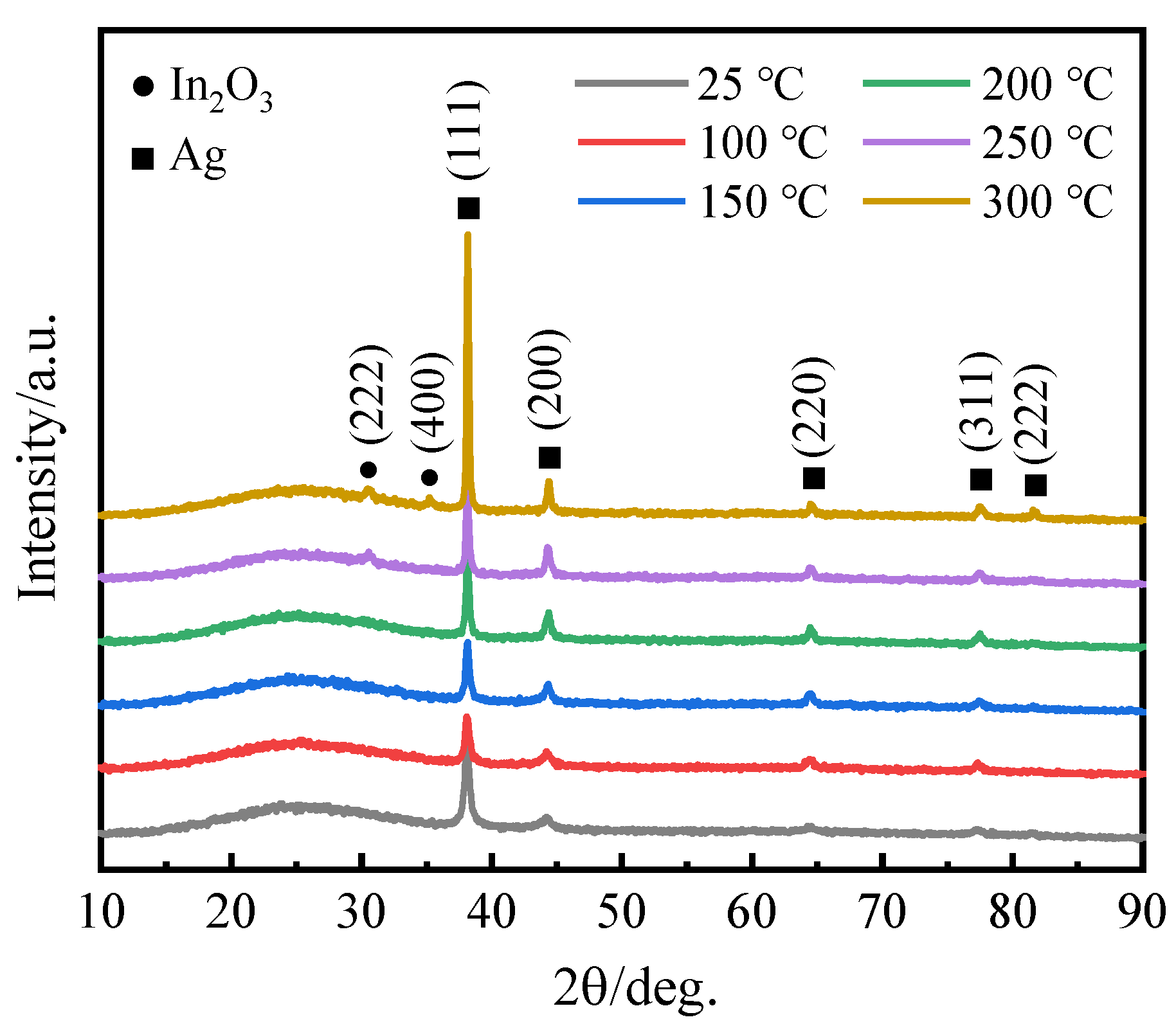

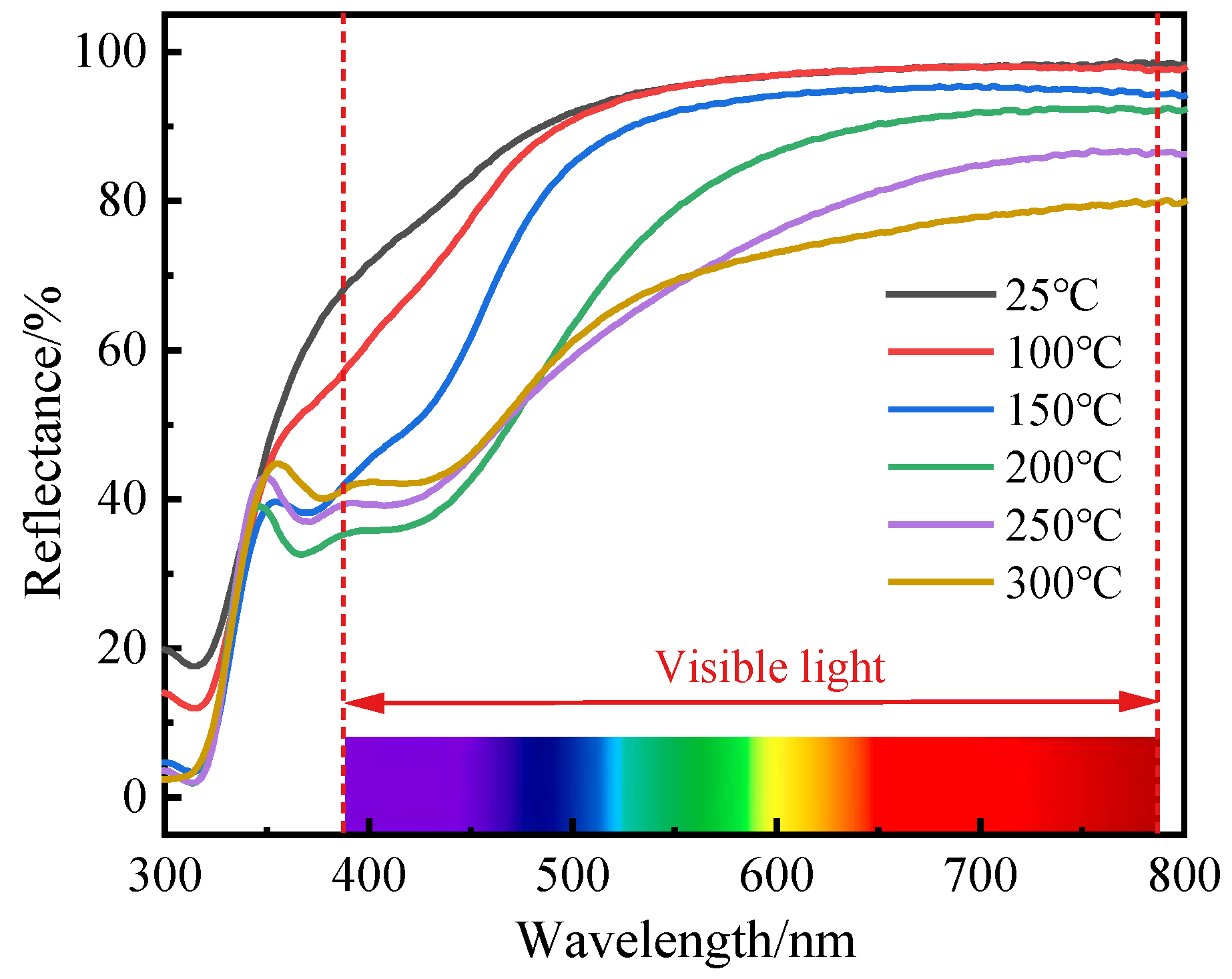
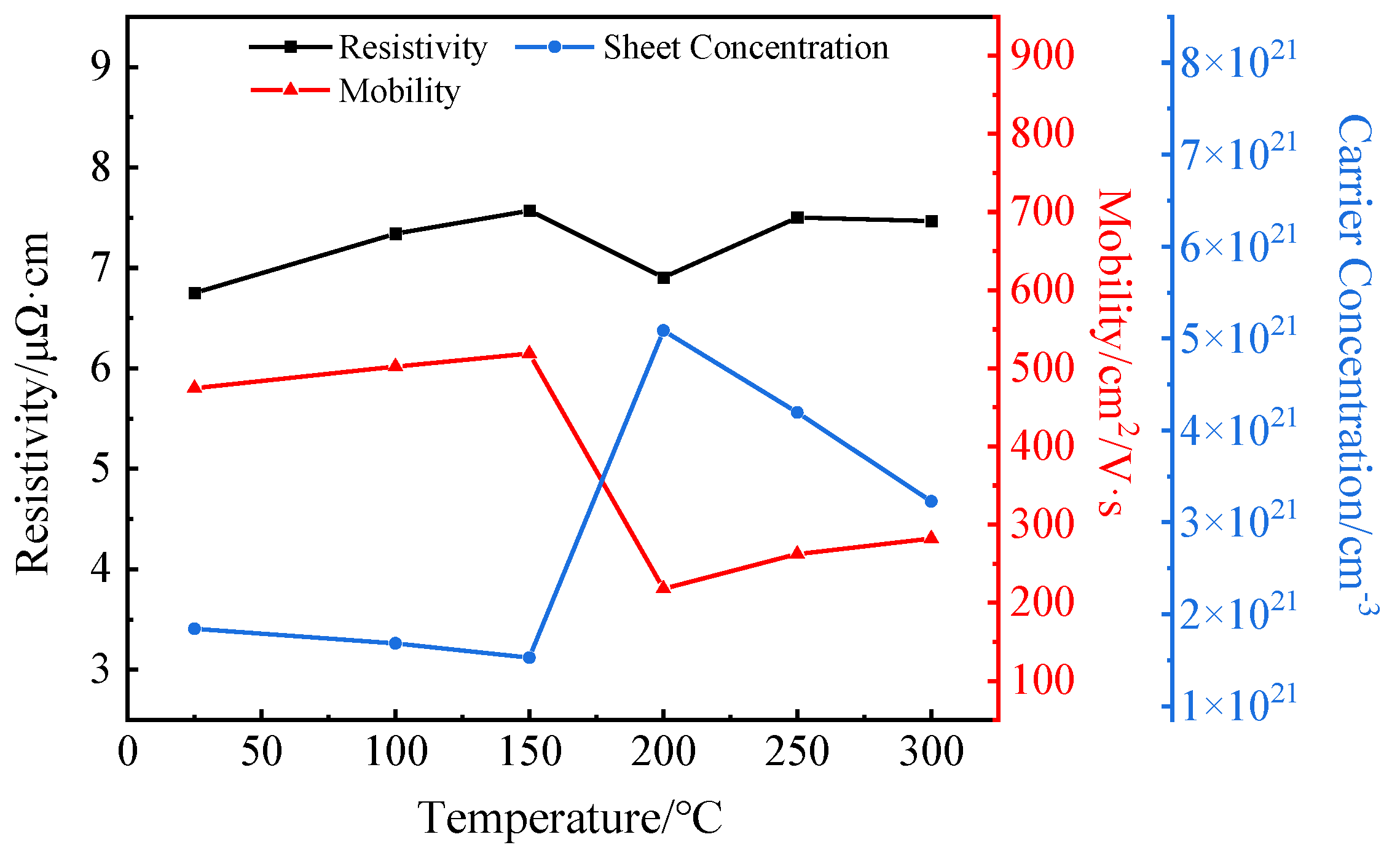
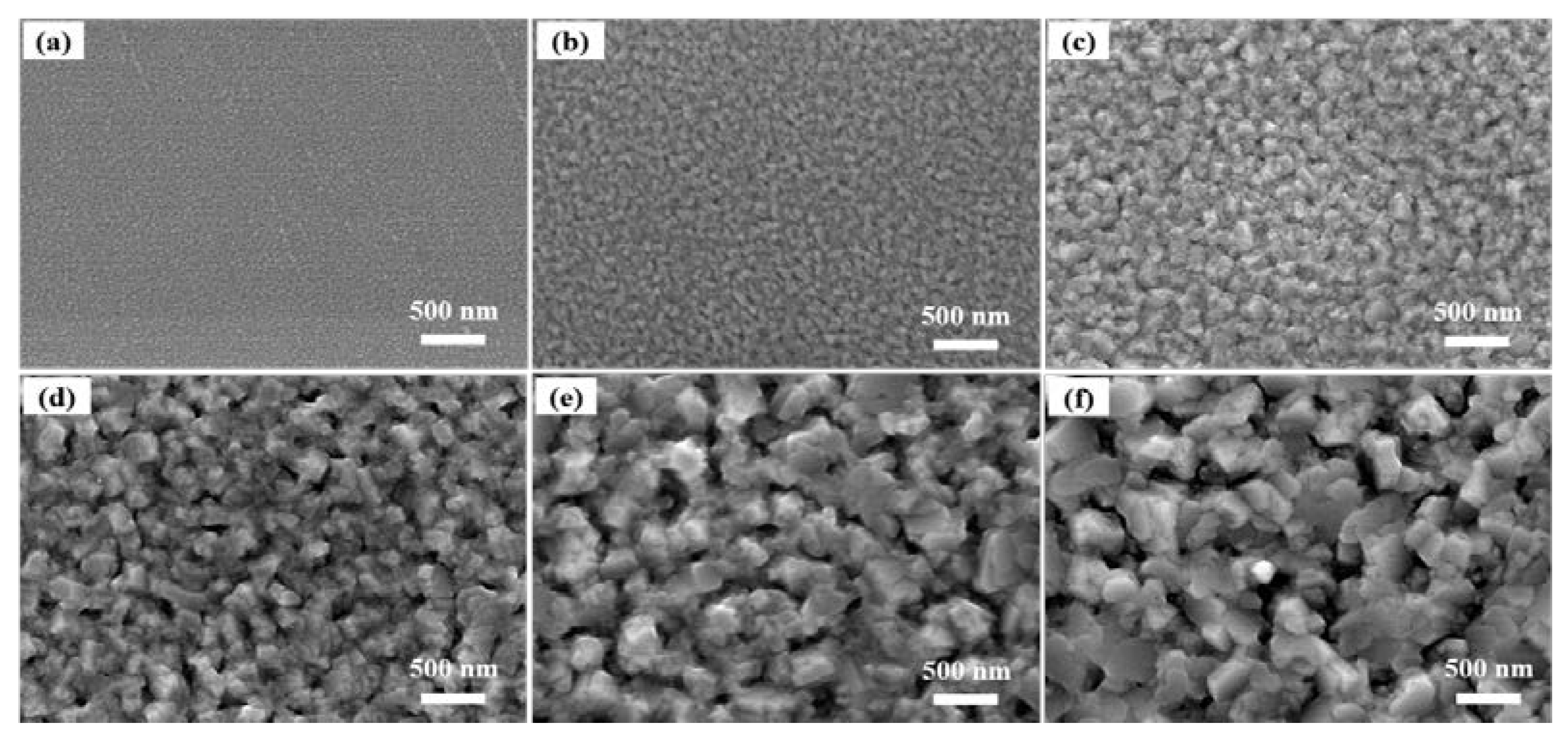

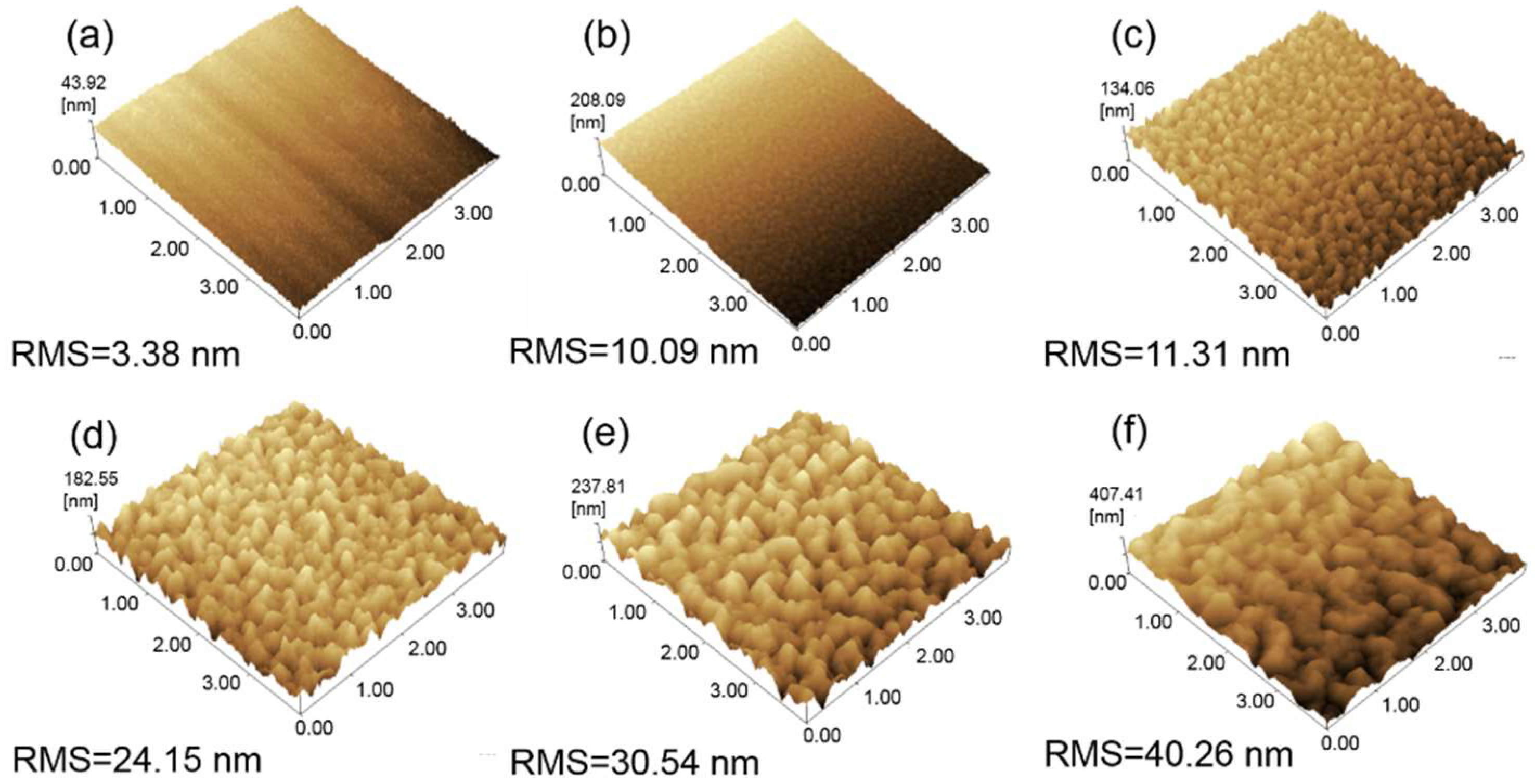
| Temperature (°C) | Reflectance at 550 nm (%) | Resistivity (Ω·cm) | References | |
|---|---|---|---|---|
| ITO/AgIn/ITO | 25 | 95.3 | 6.8 × 10−6 | Present work |
| 91.8 1 | ||||
| 250 | 68.6 | 7.4 × 10−6 | ||
| AgIn reflector | 25 | 84.0 1 | 1.9 × 10−5 | [12] |
| ITO/Ag/ITO | 25 | - | 3.5 × 10−5 | [34] |
| ITO/Ag | 25 | 92.5 | 5.3 × 10−5 | [35] |
| Ag/Glass | 25 | 97.5 2 | 3.7 × 10−6 | [36] |
| 250 | 5 2 | 5.0 × 10−6 |
Disclaimer/Publisher’s Note: The statements, opinions and data contained in all publications are solely those of the individual author(s) and contributor(s) and not of MDPI and/or the editor(s). MDPI and/or the editor(s) disclaim responsibility for any injury to people or property resulting from any ideas, methods, instructions or products referred to in the content. |
© 2023 by the authors. Licensee MDPI, Basel, Switzerland. This article is an open access article distributed under the terms and conditions of the Creative Commons Attribution (CC BY) license (https://creativecommons.org/licenses/by/4.0/).
Share and Cite
Wang, X.; Zhao, H.; Yang, B.; Li, S.; Li, Z.; Yan, H.; Zhang, Y.; Esling, C.; Zhao, X.; Zuo, L. Influence of the Sputtering Temperature on Reflectivity and Electrical Properties of ITO/AgIn/ITO Composite Films for High-Reflectivity Anodes. Materials 2023, 16, 2849. https://doi.org/10.3390/ma16072849
Wang X, Zhao H, Yang B, Li S, Li Z, Yan H, Zhang Y, Esling C, Zhao X, Zuo L. Influence of the Sputtering Temperature on Reflectivity and Electrical Properties of ITO/AgIn/ITO Composite Films for High-Reflectivity Anodes. Materials. 2023; 16(7):2849. https://doi.org/10.3390/ma16072849
Chicago/Turabian StyleWang, Xianqi, Hongda Zhao, Bo Yang, Song Li, Zongbin Li, Haile Yan, Yudong Zhang, Claude Esling, Xiang Zhao, and Liang Zuo. 2023. "Influence of the Sputtering Temperature on Reflectivity and Electrical Properties of ITO/AgIn/ITO Composite Films for High-Reflectivity Anodes" Materials 16, no. 7: 2849. https://doi.org/10.3390/ma16072849





